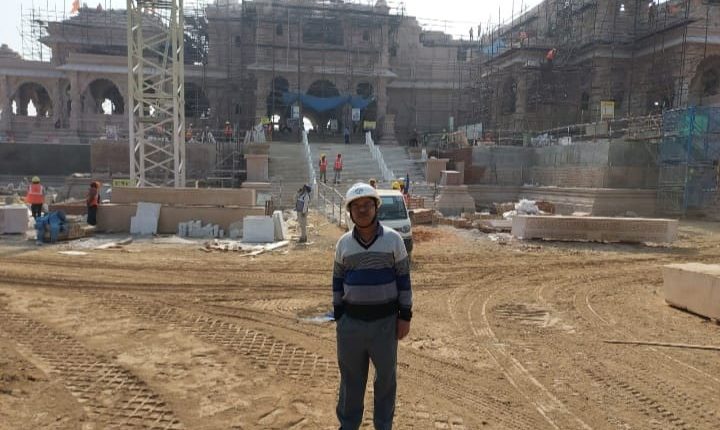A ‘tilak’ of sunlight to be used on the idol of Ram Lalla in the newly constructed Ram temple in Ayodhya on Ram Navami has been crafted by a group of scientists headed by Odia scientist Saroj Kumar Panigrahi. The scientists of Central Building Research Institute (CBRI), Roorkee, headed by Odia scientist Panigrahi, has created this inventive system entirely from brass without using electricity or batteries. The circular ‘tilak’, measuring 75 mm, on the forehead of the idol has been created by using sunlight, mirrors and lenses. The ‘tilak’ on the idol in sanctum sanctorum of the temple will be visible only on the day of Ram Navami every year.
Panigrahi said a complex arrangement of high-quality mirrors and lenses has been engineered to redirect sunlight onto the idol’s forehead for at least four minutes at 12.04 pm on every Ram Navami. He emphasized that the system won’t function in case of cloudy weather. The ‘Sun Tilak’ mechanism, scheduled to be installed on the temple’s third floor, represents a harmonious blend of human touch and scientific precision. Saroj Panigrahi, leading a team of four scientists, explained that detailed calculations ensured the alignment of the sun’s position with the English calendar date of Ram Navami, repeating every 19 years.
The intricate optomechanical system involves mirrors (M1 to M4), lenses (L1 to L4), and vertical piping with lenses (L2 and L3) fixed at specific angles. The ground floor components include mirrors (M3 & M4) and a lens (L4). Sunlight, when directed through this system, forms the distinctive shape of the ’tilak’ on the idol’s forehead. Collaborating with the Indian Institute of Astrophysics, Bengaluru, and Bengaluru-based Optics & Allied Engineering Pvt Ltd, the CBRI team prepared the blueprint for ‘Sun Tilak.’ Both organizations contributed to the fabrication of mirrors, lenses, and the tilt mechanism without any cost, although the estimated value was Rs 80 to 90 lakh. The Indian Institute of Astrophysics provided consultancy to CBRI for the optical design. Saroj Panigrahi, hailing from Paralakhemundi in Gajapati district, brings his expertise to this groundbreaking project, showcasing a fusion of tradition and cutting-edge technology.
A ‘tilak’ of sunlight to be used on the idol of Ram Lalla in the newly constructed Ram temple in Ayodhya on Ram Navami has been crafted by a group of scientists headed by Odia scientist Saroj Kumar Panigrahi. The scientists of Central Building Research Institute (CBRI), Roorkee, headed by Odia scientist Panigrahi, has created this inventive system entirely from brass without using electricity or batteries. The circular ‘tilak’, measuring 75 mm, on the forehead of the idol has been created by using sunlight, mirrors and lenses. The ‘tilak’ on the idol in sanctum sanctorum of the temple will be visible only on the day of Ram Navami every year.
Panigrahi said a complex arrangement of high-quality mirrors and lenses has been engineered to redirect sunlight onto the idol’s forehead for at least four minutes at 12.04 pm on every Ram Navami. He emphasized that the system won’t function in case of cloudy weather. The ‘Sun Tilak’ mechanism, scheduled to be installed on the temple’s third floor, represents a harmonious blend of human touch and scientific precision. Saroj Panigrahi, leading a team of four scientists, explained that detailed calculations ensured the alignment of the sun’s position with the English calendar date of Ram Navami, repeating every 19 years.
The intricate optomechanical system involves mirrors (M1 to M4), lenses (L1 to L4), and vertical piping with lenses (L2 and L3) fixed at specific angles. The ground floor components include mirrors (M3 & M4) and a lens (L4). Sunlight, when directed through this system, forms the distinctive shape of the ’tilak’ on the idol’s forehead. Collaborating with the Indian Institute of Astrophysics, Bengaluru, and Bengaluru-based Optics & Allied Engineering Pvt Ltd, the CBRI team prepared the blueprint for ‘Sun Tilak.’ Both organizations contributed to the fabrication of mirrors, lenses, and the tilt mechanism without any cost, although the estimated value was Rs 80 to 90 lakh. The Indian Institute of Astrophysics provided consultancy to CBRI for the optical design. Saroj Panigrahi, hailing from Paralakhemundi in Gajapati district, brings his expertise to this groundbreaking project, showcasing a fusion of tradition and cutting-edge technology.




